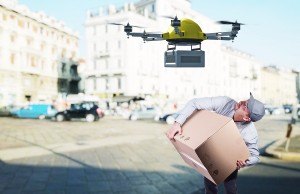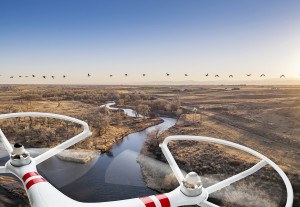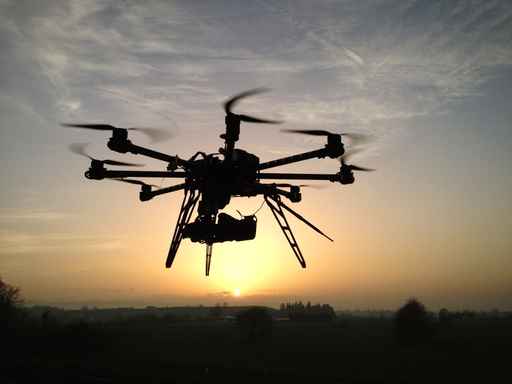As drone technology and potential applications continue to expand, corporate leaders around the world are facing a difficult question: How can drones be used to grow their businesses without harming customers and bystanders?
Executive Summary
The question has no easy answer. Officials from the Federal Aviation Administration (FAA) have been working to analyze the risks, educate the public, and develop effective ways to regulate the industry.But no regulation can eliminate the potential for risk. Companies need to take steps to reduce the risks of drone use and protect themselves, should an accident occur. Just consider the range of risks that fleets of commercial drones in the skies could bring.
Injuries
First and foremost, drone flights can lead to significant injuries. In December, a drone carrying a mistletoe collided with a woman in a Brooklyn restaurant, according to news reports, resulting in cuts to her nose and chin. (See, for example, “What It’s Like to Almost Have Your Nose Cut Off by a TGI Fridays Mistletoe Drone, December 8, 2014, Daily Intelligencer report in New York magazine online.)That followed an incident in the news last April, when a drone used to film a triathlon in Australia struck and toppled a runner just meters from the finish line.
At the same time, a growing number of commercial airline pilots have reported drones near airports, sometimes resulting in near collisions. It’s not hard to envision how a drone sucked into a jet’s engine could lead to hundreds of injuries or even fatalities.
Property damage

Civilian drones have also caused damage to property. According to news reports, a drone crashed into a home near Perth, Australia last year, leaving a hole in the roof and exposing electrical wires. This year, the International Business Times (April 14, 2015) reported that a drone delivering vegetables to a restaurant in the Netherlands crashed and burned. The drone was part of an effort by the restaurant to promote the beginning of asparagus season, the newspaper said.
Reputation damage and privacy concerns
The Netherlands crash illustrates some of the other risks drones can create for businesses. For instance, while the delivery failure may not likely affect the restaurant’s reviews, the story did receive international news coverage. That type of publicity could hurt a company’s reputation, causing them to lose business and carry the costs for a new public relations campaign.
Drones have also raised concerns about privacy because many are able to record videos and photographs from hundreds of feet in the air. In January, one U.S. senator told CNN that anyone who flies a drone over his house should be wary of ground fire. “I’ve got a shotgun,” the senator explained. (Editor’s Note: The senator was Sen. Rand Paul, R-Ky., who said this in a CNN Snapchat interview after a drone landed on the White House lawn.)
Local and state governments are seeking ways to restrict them. For example, in December, New York City council members proposed two revisions to the city’s administrative code. One would allow only operation of a drone within the limits of the city by the police or by the express authorization of the FAA. The other generally prohibits the operation of drones near sensitive sites, such as airports, subject to certain exceptions. In another example, this past January, a California state senator introduced a bill that generally provides for potential civil fines and liability with respect to flying drones less than 350 feet above ground level. Such types of proposed legislative actions also haven’t stopped one company, according to Popular Science, from creating a site akin to a do-not-call list, an online space where people can register their address to prevent drones from flying over their homes. According to reports, the company, NoFlyZone, submits the information for drone manufacturers to program the drones to navigate around those addresses.
Drone Insurance and Underwriting
 The good news is that there are steps businesses can take to mitigate the risks. That begins with understanding the individual exposures of each drone and its operators.Businesses and insurers should seek specific information in the following areas:
The good news is that there are steps businesses can take to mitigate the risks. That begins with understanding the individual exposures of each drone and its operators.Businesses and insurers should seek specific information in the following areas:
Control: How will the drone be piloted? Will it be from a home or office, within the operator’s line of sight, or a combination of these methods?
At some point, businesses that use drones will likely face the difficult question of which method strikes the best balance between potential costs and benefits.
Perhaps most important questions are those about the operators and their qualifications. A good operator will likely know how fast to fly and when conditions are too dangerous to take flight. Today, when insurers are writing an auto risk, they may evaluate the driver’s history and check motor vehicle reports for past accidents and driving infractions. Although there are no similar reports for drones that we are aware of as yet, there may be in the future. If so, such reports could play a role in the underwriting of drones.
It’s also important to consider the possibility of future federal standards for drone operators. For example, current provisions under the FAA’s proposed rules concerning eligibility for an operator certification require that the person must be at least 17 years old and pass an aeronautical knowledge exam.
But businesses may want operators of commercial drones to undergo further instruction. A number of universities already offer operator training. Before long, it would not be surprising to see national standards to measure the quality of education that schools provide.
Reliability: What are the make, model, and year of the drone? What operating system does it use? Has that drone model or operating system encountered any problems with reliability in the past?
Knowing the history and reliability of the drone and its software are critical to understanding potential risks.
Capabilities: How high can it fly? How long can it remain in the air? If the drone exceeds its limits, it could malfunction and collide with a car, building, or person.
How much weight can the drone carry? If it is overloaded, both drone and cargo could be lost and potentially damage property or hurt people on the ground.
Uses: Finally, it’s important for businesses to review their plans to use drones. In the not so distant future, we could see nearly every industry and function present drone risks, though likely different both in type and severity.
For example, a drone that films a wedding reception with hundreds of guests could present different risks than one that surveys an area that has been evacuated and destroyed by a storm. The same could be true for security and privacy concerns: A drone operating in a rural area might lose power and break down, but chances are likely lower that it would crash into people or invade their privacy, as it might in an urban area.
Insurance: One way to protect against potential losses is to purchase drone insurance. Last year, in addition to drone-related exclusion options, ISO filed drone-related coverage options for its general liability and umbrella/excess programs. The endorsements were filed on a multistate basis and will be implemented in a majority of ISO jurisdictions in June 2015.
ISO is also considering the development of options relating to drones for several of its commercial lines property programs, such as commercial property, businessowners, farm, and commercial inland marine.
No matter what coverage a policyholder currently has, it’s important to remember that the world of drones is just beginning to take shape. Those who understand the potential risks and solutions will likely be the most prepared to benefit.





















 AI-Powered Insurance Product Development Is Going to Take Some Powering Through
AI-Powered Insurance Product Development Is Going to Take Some Powering Through  Time-Tested Loss Reserving Methods Challenged: AM Best
Time-Tested Loss Reserving Methods Challenged: AM Best  That Insurance Talent Crisis? It’s a Global Knowledge Opportunity
That Insurance Talent Crisis? It’s a Global Knowledge Opportunity  AM Best Downgrades State Farm General Ratings
AM Best Downgrades State Farm General Ratings 






